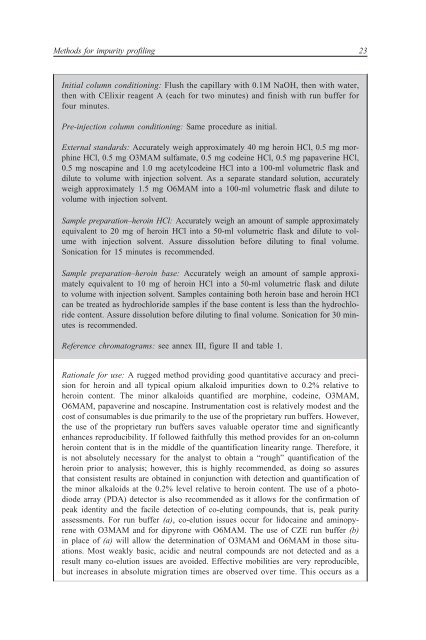methods for impurity profiling of heroin and cocaine - United Nations ...
methods for impurity profiling of heroin and cocaine - United Nations ...
methods for impurity profiling of heroin and cocaine - United Nations ...
You also want an ePaper? Increase the reach of your titles
YUMPU automatically turns print PDFs into web optimized ePapers that Google loves.
Methods <strong>for</strong> <strong>impurity</strong> <strong>pr<strong>of</strong>iling</strong> 23<br />
Initial column conditioning: Flush the capillary with 0.1M NaOH, then with water,<br />
then with CElixir reagent A (each <strong>for</strong> two minutes) <strong>and</strong> finish with run buffer <strong>for</strong><br />
four minutes.<br />
Pre-injection column conditioning: Same procedure as initial.<br />
External st<strong>and</strong>ards: Accurately weigh approximately 40 mg <strong>heroin</strong> HCl, 0.5 mg morphine<br />
HCl, 0.5 mg O3MAM sulfamate, 0.5 mg codeine HCl, 0.5 mg papaverine HCl,<br />
0.5 mg noscapine <strong>and</strong> 1.0 mg acetylcodeine HCl into a 100-ml volumetric flask <strong>and</strong><br />
dilute to volume with injection solvent. As a separate st<strong>and</strong>ard solution, accurately<br />
weigh approximately 1.5 mg O6MAM into a 100-ml volumetric flask <strong>and</strong> dilute to<br />
volume with injection solvent.<br />
Sample preparation–<strong>heroin</strong> HCl: Accurately weigh an amount <strong>of</strong> sample approximately<br />
equivalent to 20 mg <strong>of</strong> <strong>heroin</strong> HCl into a 50-ml volumetric flask <strong>and</strong> dilute to volume<br />
with injection solvent. Assure dissolution be<strong>for</strong>e diluting to final volume.<br />
Sonication <strong>for</strong> 15 minutes is recommended.<br />
Sample preparation–<strong>heroin</strong> base: Accurately weigh an amount <strong>of</strong> sample approximately<br />
equivalent to 10 mg <strong>of</strong> <strong>heroin</strong> HCl into a 50-ml volumetric flask <strong>and</strong> dilute<br />
to volume with injection solvent. Samples containing both <strong>heroin</strong> base <strong>and</strong> <strong>heroin</strong> HCl<br />
can be treated as hydrochloride samples if the base content is less than the hydrochloride<br />
content. Assure dissolution be<strong>for</strong>e diluting to final volume. Sonication <strong>for</strong> 30 minutes<br />
is recommended.<br />
Reference chromatograms: see annex III, figure II <strong>and</strong> table 1.<br />
Rationale <strong>for</strong> use: A rugged method providing good quantitative accuracy <strong>and</strong> precision<br />
<strong>for</strong> <strong>heroin</strong> <strong>and</strong> all typical opium alkaloid impurities down to 0.2% relative to<br />
<strong>heroin</strong> content. The minor alkaloids quantified are morphine, codeine, O3MAM,<br />
O6MAM, papaverine <strong>and</strong> noscapine. Instrumentation cost is relatively modest <strong>and</strong> the<br />
cost <strong>of</strong> consumables is due primarily to the use <strong>of</strong> the proprietary run buffers. However,<br />
the use <strong>of</strong> the proprietary run buffers saves valuable operator time <strong>and</strong> significantly<br />
enhances reproducibility. If followed faithfully this method provides <strong>for</strong> an on-column<br />
<strong>heroin</strong> content that is in the middle <strong>of</strong> the quantification linearity range. There<strong>for</strong>e, it<br />
is not absolutely necessary <strong>for</strong> the analyst to obtain a “rough” quantification <strong>of</strong> the<br />
<strong>heroin</strong> prior to analysis; however, this is highly recommended, as doing so assures<br />
that consistent results are obtained in conjunction with detection <strong>and</strong> quantification <strong>of</strong><br />
the minor alkaloids at the 0.2% level relative to <strong>heroin</strong> content. The use <strong>of</strong> a photodiode<br />
array (PDA) detector is also recommended as it allows <strong>for</strong> the confirmation <strong>of</strong><br />
peak identity <strong>and</strong> the facile detection <strong>of</strong> co-eluting compounds, that is, peak purity<br />
assessments. For run buffer (a), co-elution issues occur <strong>for</strong> lidocaine <strong>and</strong> aminopyrene<br />
with O3MAM <strong>and</strong> <strong>for</strong> dipyrone with O6MAM. The use <strong>of</strong> CZE run buffer (b)<br />
in place <strong>of</strong> (a) will allow the determination <strong>of</strong> O3MAM <strong>and</strong> O6MAM in those situations.<br />
Most weakly basic, acidic <strong>and</strong> neutral compounds are not detected <strong>and</strong> as a<br />
result many co-elution issues are avoided. Effective mobilities are very reproducible,<br />
but increases in absolute migration times are observed over time. This occurs as a

















